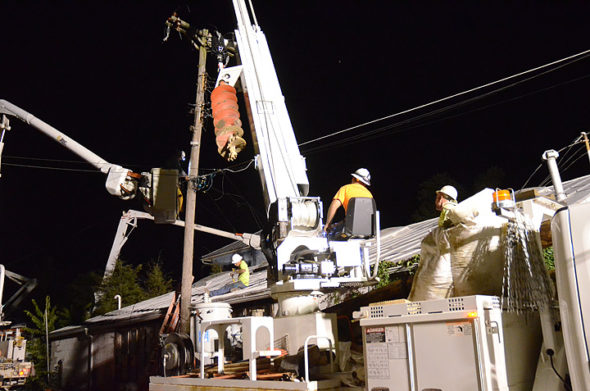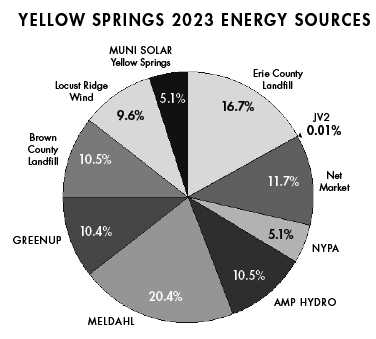
At the Monday, Oct. 16 regular Village Council meeting, consultant John Courtney provided Council members with up-to-date data on the Village’s energy profile, including a round-up on the present sources of our municipal energy. (Photo by Matt Minde)
Village Council reviews the local power portfolio
- Published: October 24, 2023
Where does the Village of Yellow Springs get its energy? How much of it is renewable? And how many renewable energy credits does the Village get from the kinds of energy it uses and produces?
These questions were broached at the most recent Village Council regular meeting on Monday, Oct. 16, when consultant John Courtney of Findlay-based Courtney and Associates went before Council to detail the Village’s power supply requirements and resources.
Courtney appeared in front of the group at the behest of Interim Village Manager Johnnie Burns, who, since assuming the manager position last month, has advised Council to consider the ways in which the municipality consumes and distributes energy — especially as local reliance on electricity shows no signs of decreasing, as detailed in a discussion at the Sept. 18 Council meeting.
Courtney began his presentation Monday by noting that, on average, Yellow Springs consumes “roughly” 37 million kilowatt hours, or kWh, of energy per year — a figure that Courtney noted has been “consistent” in Yellow Springs over the last several years, according to data provided by American Municipal Power, the Village’s electric power provider.
“And actually, 2023 is a little lower than that average,” Courtney said. “We had a pretty mild winter and spring; the overall usage is down now.”
In a phone interview with Courtney following the Council meeting, he told the News that Yellow Springs is “on the lower end” of energy usage, at least, as it compares to the nearly 70 municipalities throughout the Midwest with which Courtney’s consulting company works.
“[Yellow Springs] is a bedroom community — mostly residential,” he said. “Compared to other municipalities that are about the size of the village, there’s less usage and demand per capita or per customer than we typically find. You don’t have the heavy industrial load we see elsewhere.”

The largest percentage of our energy — approximately 41% — comes from the Greenup, Meldahl and AMP hydroelectric facilities along the Ohio River Watershed. The second largest percentage — about 27% — comes from the combined energy generated by the methane produced in the Brown County and Erie County landfills. 9.6% of our energy comes from the Locust Ridge wind farm in Pennsylvania, 5.1% from our local solar array at Glass Farm, 11.7% from the larger energy market and less than 0.01% is generated by JV2 diesel-powered gas turbines. (Data provided by Courtney & Associates, American Municipal Power)
Going to the sources
As Courtney explained in his presentation, with data provided from AMP, approximately 41% of the Village’s power is generated from five hydroelectric plants along the Ohio River watershed, with plants as far east as the Ohio-Pennsylvania border, and as far west as where the Ohio River spills into the Mississippi River at the southern tip of Illinois.
According to Courtney, the Meldahl, Greenup, Smithland, Cannelton and Willow Creek hydroelectric facilities were all built on existing dams initially constructed by the Army Corps of Engineers for barge traffic on the Ohio River. Taken together, these five hydroelectric facilities generate, in total, 3.5 megawatts of “capacity” for the village — that is, what can effectively serve the municipal “peak load” usage, Courtney told the News.
In addition to these power supply resources, Yellow Springs gets nearly 17% of its energy from the methane produced by the Erie County landfill in Milan, Ohio, which generates 700 kWh of capacity; around 10% from the Brown County landfill, 69 miles south of Yellow Springs, which generates 440 kWh of capacity; another 10% from the 50 wind turbines on the Locust Wind Ridge Project in northwest Pennsylvania, which generates 1,600 kWh of capacity; around 5% from the New York Power Authority, which is composed of two federal hydroelectric projects along the Niagara and St. Lawrence rivers that generate 330 kWh of capacity; and around 5% from the 1.8 mWh/year solar array on the Village-owned Glass Farm, which is run by AEP Onsite Partners. The remainder of the Village’s power comes from the net market.
As Courtney noted in his presentation, contracts with several of these energy producers are set to expire in the next few years: The Locust Ridge Wind contract expires at the end of 2025, the Erie County landfill in 2028 and the Brown County landfill in 2031.
“So the Village is going to have to take a look at and deal with [these contracts] soon,” Courtney cautioned Council.
Of what each of these energy producers is able to generate, Courtney said that the figures AMP provided are estimates, or “forecasts” that can vary depending on conditions.
“Sometimes the Ohio River has a low water flow; sometimes it’s not very windy in northwest Pennsylvania — these conditions obviously impact how much energy can be generated,” he said.
Revisiting RECs
A major component of Courtney’s presentation on the Village’s energy portfolio entailed reminding Council of its ability to buy and sell renewable energy credits, or RECs.
RECs are a quasi commodity that can be used in green energy markets; they are tied to the purchase of energy from renewable sources. Like most commodities, RECs can be purchased and sold.
“These are certificates that represent the environmental attributes of one megawatt-hour [mWh] of electricity generated from a renewable source,” Courtney reminded Council.
Presently, the Village receives 23,800 RECs per year from its existing renewable energy sources listed above. In market value, those RECs equate to $522,599.
“Which is not insignificant by any means,” Courtney said.
The relative market value of each of the RECs the Village earns from the purchase of its energy varies depending on the source. For example, the purchasing of energy from the Meldahl and Greenup hydroelectric facilities earns the Village thousands more RECs than the Village’s own solar field. As an additional example, the Locust Ridge wind farm, while generating renewable energy, provides the Village with no RECs.
Courtney noted that if the Village wants to be “100% renewable” — which is to say, reliant entirely on hydroelectric, solar, wind or other “green” energy sources, or in possession of enough RECs generated by other municipalities that get their energy from renewable sources — then the Village would have to acquire or produce 13,000 more RECs.
“It’s a 37,000 mWh energy requirement to get to 100% renewable,” Courtney said.
As previously reported in the News, Council has both considered and approved the sale of RECs in recent years.
First, in 2020, Council authorized former Village Manager Josué Salmerón to sell a portion of the Village’s portfolio of RECs earned from 2016–2019 — a sale that, according to Interim Village Manager Johnnie Burns, made the Village $497,020. In that sale, the Village also purchased around $30,000 in “green e-RECs.”
That 2020 decision to sell RECs marked a change in policy, as previous Councils chose to retain all its credits earned by purchasing renewable energy.
As Courtney described the 2020 sale: “In the end, you bought back what you sold. Not enough to cover the whole energy requirement of the Village, but you bought enough green e-RECs to recover what you sold.”
Then, in 2021, the Village received $180,024 from another sale of RECs — in particular, ones generated from hydroelectric purchases, according to Burns.
Burns also told the News that the Village is presently in the process of working with AMP to sell another round of RECs, but only once AMP brokers a deal and Council approves the sale at a later meeting.
As in the past, there was slight disagreement at Monday’s Council meeting over both the value and the environmental ethics of dealing in RECs, as well as the meaning of “renewability” in general.
“I think we’ve been conflating the actual renewable resources that are going into our energy needs and the claims of renewability made by RECs,” Council member Gavin DeVore Leonard said.
Council member Marianne MacQueen added: “My sense is that when we’ve been talking about our energy being mostly renewable, we’re talking about the actual energy we’re using — the contracts, and not necessarily the RECs.”
Striking an optimistic tone, Council President Kevin Stokes said he was ultimately pleased with the direction in which the Village was going toward expanding its renewable energy usage — despite that it doesn’t always provide the Village with RECs.
“We’re at a bonafide 88.2% for our energy coming from renewables,” he said. “That feels good.”
Council made no decisions regarding the sale of RECs or reorganizing the Village’s energy portfolio following Courtney’s presentation.
Additional coverage of the Monday, Oct. 16, Village Council meeting will appear in next week’s issue of the News.
2 Responses to “Village Council reviews the local power portfolio”
The Yellow Springs News encourages respectful discussion of this article.
You must login to post a comment.
Don't have a login? Register for a free YSNews.com account.













It seems to me that the Akashic records closely parallels theoretical ideas that our whole shebang is a simulation which basically encodes every detail in order to work. Energy.
“Quantum physics says there exists a universal energy that has the attributes of God. This energy has consciousness and creativity. All matter is composed of this energy. This energy was responsible for the Big Bang.”
The Village should tread carefully in its public pronouncements. The USEPA is clear in its expectations with regard to the treatment of RECS. From their best practices:
“Before making any claims about using (renewable) power, make sure you own the environmental attributes associated with your system or for systems registered in a tracking system that you own the RECs or have had them retired on your behalf in the system”
“RECs are legal instruments that contractually convey the attributes of renewable electricity (i.e. environmental attributes) to their owner. As such, the REC owner has exclusive rights to make claims— either explicitly or implicitly—about “using” or “being powered with” the renewable electricity associated with that REC, as well as the associated claims about carbon footprint reductions.”
“If you are claiming to use solar electricity, ensure you either own or have exclusive contractual rights to the environmental attributes or RECs to substantiate your claims.”
“We suggest that in any press release or public statement, you define what RECs are and who owns them.”